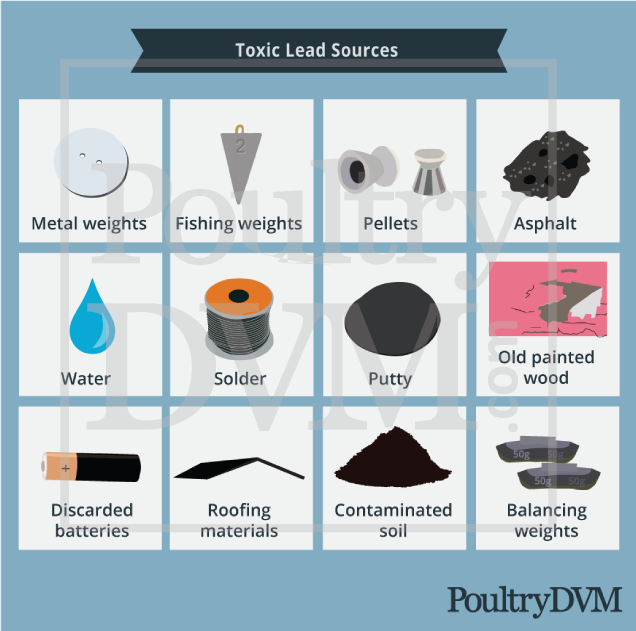Lead poisoning is an increasingly common problem in backyard chickens living in urban environments. It is not only detrimental to the bird's health, but also to the humans who consume the eggs laid by the hens. In one study conducted on backyard hens living in the Boston area, 98% of the eggs contained detectable concentrations of lead, due to exposure to contaminated soil.
Lead is a very dense metal and a strong neurotoxin. If ingested, since the metal is so dense and not easily oxidized, it will remain in the chicken's gastrointestinal tract. There it will slowly get absorbed and released into the bloodsteam, resulting in anemia and interference with the bird's ability to absorb calcium (leading to hypocalcemia, especially in hens).
Clinical Presentation
Lead poisoning can present in chickens in acute or chronic form, depending on the extent of exposure and the amount of lead ingested.
- Acute form: Results in sudden onset of muscle weakness, loss of appetite, marked weight loss, ataxia, drop in egg production and severe anemia.
- Chronic form: Causes demyelination of the vagus and other nerves, which results in decreased gastrointestinal motility secondary to blockage of nerve conduction. Chickens often present with delayed crop emptying, sour crop, or crop impactions. Greenish diarrhea may stain feathers around the vent (pasty butt).
How Lead Poisoning is Diagnosed
Lead poisoning can be confirmed through a simple blood test----by sending a small sample of the chicken's blood to a laboratory to confirm the presence of elevated concentrations of lead. Amounts of 11 u/dL and above are indicative of toxicity. In some cases, lead particles may be seen in radiographs, however not in all cases. Radiographic identification of a metallic foreign body with clinical signs of lead toxicosis is suggestive of lead poisoning. However, the absence of metallic density does not rule out lead toxicosis.
Treatment for Lead Poisoning
Treatment of chickens with lead poisoning consists of four different aspects: supportive care, chelation therapy, removal of the foreign bodies, and elimination of the source of lead from the bird's environment.
- Supportive care: May include fluid therapy, parenteral multivitamins, and tube feeding.
- Chelation therapy: Various agents include edetate calcium disodium (CaEDTA), D-penicillamine, and dimercaptosuccinic acid. CaEDTA is the agent of choice to initiate therapy, because birds often have decreased gastric motility or are regurgitating. Combination therapy can be used in severe cases. More than one course of treatment may be necessary, as lead concentrations equilibrate from the soft tissue into the bone and blood. CaEDTA chelates lead in the bone and the blood, but not in the soft tissue.
- Removal of the foreign body: Can be achieved with administration of cathartics such as mineral oil, peanut butter, and magnesium sulfate (Epsom salt), which may facilitate the passage of small metallic particles through the digestive system. Endoscopy may also be used to retrieve metallic particles, but endoscopic removal of small particles may be difficult and sometimes impossible if ingesta are present in the proventriculus and ventriculus. Proventricular and ventricular flushing assisted with fluoroscopy is another means to remove foreign material.
Common Sources of Lead
Common sources of lead exposure include:
- Lead-contaminated soil: There are many ways that soil can become contaminated with lead. Soil located on the side of the road of busy streets is frequently contaminated with lead, since lead was an ingredient in gasoline until the late 1970s. Soil that surrounds older painted structures, as lead-based paint may still be in the soil adjacent the building. Note that 74% of privately owned US homes built before 1980 still contain hazardous quantities of lead paint. The land could also contain lead contaminated waste (batteries, asphalt products, leaded gasoline, lead shot, putty, and spent oil) which may be above or buried within the soil. Any vegetation that grows on the soil will be contaminated with lead, making the vegetation hazardous to chickens who frequently seek out forage to eat when free ranging in grass.
- Lead-contaminated water: Water can become contaminated with lead if it flows through old lead pipes or faucets--which was common during pre-1978 days.
- Lead-contaminated food: Food that is stored or left for long periods of time in ceramic glazed bowls or glass (especially for red and yellow shades), or imported from countries that use lead to seal canned food.
- Consumer products: Batteries, curtain weights, foil from champagne bottles, stained glass, chandeliers, electronic devices, ammunition, inks, small toys, lubricants, bearings, linoleum, jewelry, fishing gear, solder, ceramics, and plastics.
- Building materials: Lead is used in roofing material, cladding, flashing, gutters and gutter joints, and on roof parapets.
- Sound dampening materials: Sheet-lead is used as a sound deadening layer in the walls, floors, and ceilings of sound studios.

